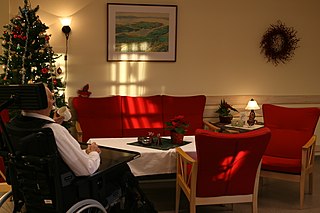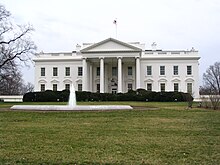
Medicaid in the United States is a federal and state program that helps with healthcare costs for some people with limited income and resources. Medicaid also offers benefits not normally covered by Medicare, including nursing home care and personal care services. The main difference between the two programs is that Medicaid covers healthcare costs for people with low incomes while Medicare provides health coverage for the elderly. There are also dual health plans for people who have both Medicaid and Medicare. The Health Insurance Association of America describes Medicaid as "a government insurance program for persons of all ages whose income and resources are insufficient to pay for health care."

The United States Department of Health and Human Services (HHS), is a cabinet-level executive branch department of the U.S. federal government created to protect the health of all Americans and providing essential human services. Its motto is "Improving the health, safety, and well-being of America". Before the separate federal Department of Education was created in 1979, it was called the Department of Health, Education, and Welfare (HEW).

Medicare is a government national health insurance program in the United States, begun in 1965 under the Social Security Administration (SSA) and now administered by the Centers for Medicare and Medicaid Services (CMS). It primarily provides health insurance for Americans aged 65 and older, but also for some younger people with disability status as determined by the SSA, including people with end stage renal disease and amyotrophic lateral sclerosis.

The Centers for Medicare & Medicaid Services (CMS), is a federal agency within the United States Department of Health and Human Services (HHS) that administers the Medicare program and works in partnership with state governments to administer Medicaid, the Children's Health Insurance Program (CHIP), and health insurance portability standards. In addition to these programs, CMS has other responsibilities, including the administrative simplification standards from the Health Insurance Portability and Accountability Act of 1996 (HIPAA), quality standards in long-term care facilities through its survey and certification process, clinical laboratory quality standards under the Clinical Laboratory Improvement Amendments, and oversight of HealthCare.gov. CMS was previously known as the Health Care Financing Administration (HCFA) until 2001.
AARP is an interest group in the United States focusing on issues affecting those over the age of fifty. The organization said it had more than 38 million members in 2018. The magazine and bulletin it sends to its members are the two largest-circulation publications in the United States.

The Social Security Amendments of 1965, Pub.L. 89–97, 79 Stat. 286, enacted July 30, 1965, was legislation in the United States whose most important provisions resulted in creation of two programs: Medicare and Medicaid. The legislation initially provided federal health insurance for the elderly and for financially challenged families.

Elderly care, or simply eldercare, serves the needs and requirements of senior citizens. It encompasses assisted living, adult daycare, long-term care, nursing homes, hospice care, and home care. Because of the wide variety of elderly care needs and cultural perspectives on the elderly, it includes a broad range of practices and institutions. For example, government-run elderly care is seldom used in many Asian countries, where younger generations often care for the elderly.
Program of All-inclusive Care for the Elderly (PACE) are programs within the United States that provide comprehensive health services for individuals age 55 and over who are sufficiently frail to be categorized as "nursing home eligible" by their state's Medicaid program. The ultimate goal of PACE programs is to keep eligible older adults out of nursing homes and within their communities for as long as possible. Services include primary and specialty medical care, nursing, nutrition, social services, therapies, pharmaceuticals, day health center services, home care, health-related transportation, minor modification to the home to accommodate disabilities, and anything else the program determines is medically necessary to maximize a member's health. If you or a loved one are eligible for nursing home level care but prefer to continue living at home, a PACE program can provide expansive health care and social opportunities during the day while you retain the comfort and familiarity of your home outside of day hours.

The Alliance for Retired Americans (ARA) is a 501(c)(4) non-profit organization and nonpartisan organization of retired trade union members affiliated with the AFL-CIO, which founded it in 2001. The group's membership also includes non-union, community-based activists. Its predecessor organization was known as the National Council of Senior Citizens (NCSC).
Nelson Hale Cruikshank was known nationally in the United States as an expert on Social Security, Medicare and policy on aging. He was a Methodist minister, labor union activist and the first director of the Department of Social Security at the AFL–CIO before entering government service in his mid-60s.

The United States federal budget is divided into three categories: mandatory spending, discretionary spending, and interest on debt. Also known as entitlement spending, in US fiscal policy, mandatory spending is government spending on certain programs that are required by law. Congress established mandatory programs under authorization laws. Congress legislates spending for mandatory programs outside of the annual appropriations bill process. Congress can only reduce the funding for programs by changing the authorization law itself. This requires a 60-vote majority in the Senate to pass. Discretionary spending on the other hand will not occur unless Congress acts each year to provide the funding through an appropriations bill.
CD Publications began as a news service firm located just outside Washington DC, United States. It produces Web-based "news services" whose topics of coverage include housing, health care, education, funding, aging and Native Americans.

Many retirement issues for lesbian, gay, bisexual, transgender (LGBT) and intersex people are unique from their non-LGBTI counterparts and these populations often have to take extra steps addressing their employment, health, legal and housing concerns to ensure their needs are met. Throughout the United States, " 2 million people age 50 and older identify as LGBT, and that number is expected to double by 2030", estimated in a study done by the Institute for Multigenerational Health at the University of Washington. In 1969, the Stonewall Riots marked the start of the modern gay rights movement and increasingly LGBTQ+ people have become more visible and accepted into mainstream cultures. LGBTQ+ elders and retirees are still considered a newer phenomenon creating challenges and opportunities as a range of aging issues are becoming more understood as those who live open lives redefine commonly held beliefs and as retirees newly come out of the closet.
The National Committee to Preserve Social Security and Medicare(NCPSSM) is a United States liberal advocacy group whose goal is to protect Social Security and Medicare. NCPSSM works to preserve entitlement programs through direct mail campaigns, candidate endorsements, incumbent ratings, grassroots activity, issue advertising, and campaign contributions.
Bertha Sheppard Adkins, was an educator, political activist, public servant, and a community leader.

The Older Americans Act of 1965 was the first federal level initiative aimed at providing comprehensive services for older adults. It created the National Aging Network comprising the Administration on Aging on the federal level, State Units on Aging at the state level, and Area Agencies on Aging at the local level. The network provides funding—based primarily on the percentage of an area's population 60 and older—for nutrition and supportive home and community-based services, disease prevention/health promotion services, elder rights programs, the National Family Caregiver Support Program, and the Native American Caregiver Support Program.
The Pennsylvania Department of Aging is a cabinet-level agency charged with providing aid to Pennsylvania's approximately three million individuals age 60 and older. Although the bureau operates some services directly, such as the Pharmaceutical Contact for the Elderly (PACE) prescription drug program, it generally serves as a clearinghouse of funding and information for county-level Area Agencies on Aging. The department was formed under the governorship of Milton Shapp.
Paul E. Harenberg was an American politician from New York. He was a member of the New York State Assembly, representing the 5th Assembly district, from 1975 to 2000.

Dorcas Ruth Hardy was a former federal government official. Hardy served as the 10th Commissioner of the United States Social Security Administration (SSA) from 1986 to 1989. She was the first woman to serve as SSA Commissioner.
As of 2017, approximately 1.4 million Americans live in a nursing home, two-thirds of whom rely on Medicaid to pay for their care. Residential nursing facilities receive Medicaid federal funding and approvals through a state health department. These facilities may be overseen by various types of state agency.








